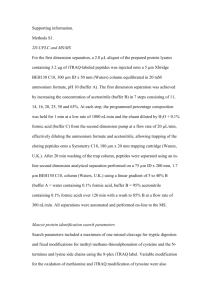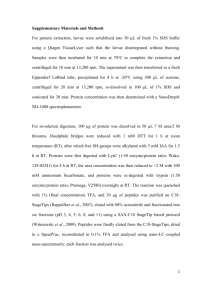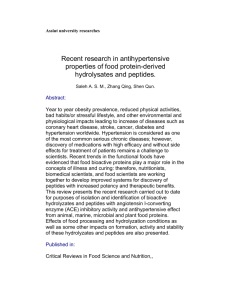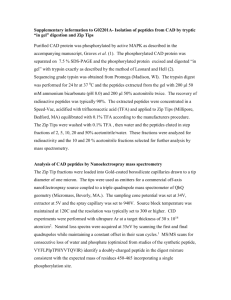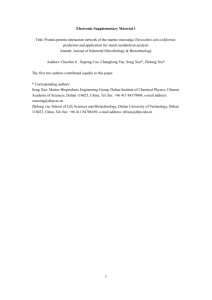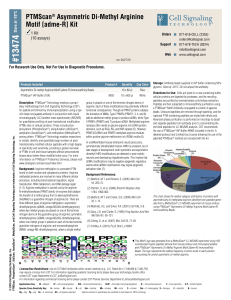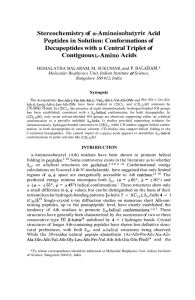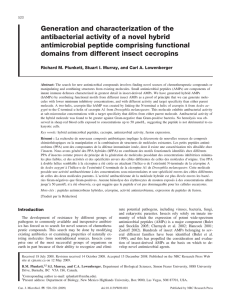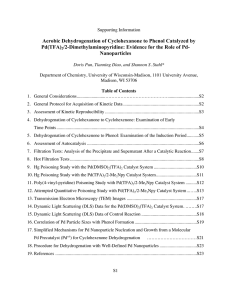Supporting Information Ribosomal Synthesis of Dehydroalanine Containing Peptides
advertisement
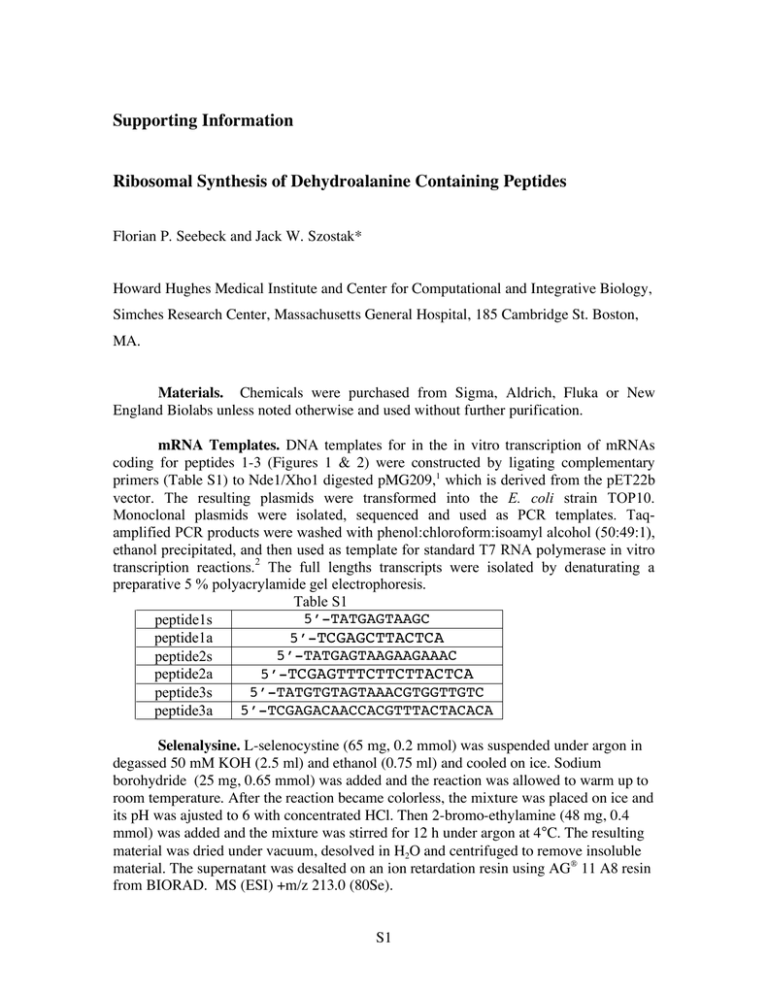
Supporting Information Ribosomal Synthesis of Dehydroalanine Containing Peptides Florian P. Seebeck and Jack W. Szostak* Howard Hughes Medical Institute and Center for Computational and Integrative Biology, Simches Research Center, Massachusetts General Hospital, 185 Cambridge St. Boston, MA. Materials. Chemicals were purchased from Sigma, Aldrich, Fluka or New England Biolabs unless noted otherwise and used without further purification. mRNA Templates. DNA templates for in the in vitro transcription of mRNAs coding for peptides 1-3 (Figures 1 & 2) were constructed by ligating complementary primers (Table S1) to Nde1/Xho1 digested pMG209,1 which is derived from the pET22b vector. The resulting plasmids were transformed into the E. coli strain TOP10. Monoclonal plasmids were isolated, sequenced and used as PCR templates. Taqamplified PCR products were washed with phenol:chloroform:isoamyl alcohol (50:49:1), ethanol precipitated, and then used as template for standard T7 RNA polymerase in vitro transcription reactions.2 The full lengths transcripts were isolated by denaturating a preparative 5 % polyacrylamide gel electrophoresis. Table S1 5’-TATGAGTAAGC peptide1s peptide1a 5’-TCGAGCTTACTCA 5’-TATGAGTAAGAAGAAAC peptide2s peptide2a 5’-TCGAGTTTCTTCTTACTCA 5’-TATGTGTAGTAAACGTGGTTGTC peptide3s 5’-TCGAGACAACCACGTTTACTACACA peptide3a Selenalysine. L-selenocystine (65 mg, 0.2 mmol) was suspended under argon in degassed 50 mM KOH (2.5 ml) and ethanol (0.75 ml) and cooled on ice. Sodium borohydride (25 mg, 0.65 mmol) was added and the reaction was allowed to warm up to room temperature. After the reaction became colorless, the mixture was placed on ice and its pH was ajusted to 6 with concentrated HCl. Then 2-bromo-ethylamine (48 mg, 0.4 mmol) was added and the mixture was stirred for 12 h under argon at 4°C. The resulting material was dried under vacuum, desolved in H2O and centrifuged to remove insoluble material. The supernatant was desalted on an ion retardation resin using AG® 11 A8 resin from BIORAD. MS (ESI) +m/z 213.0 (80Se). S1 Peptide translation. The composition of the reconstituted Escherichia coli has been described previously.3, 4 Usually these systems employ a polymix buffer containing a complex mixture of cations.5 For the sake of simplicity we used a simplified buffer with the following composition: 10 mM Tris-HCl, 10 mM Mg(OAc)2, 100 mM NH4Cl pH 7.5 (at 37°C). Translation reactions (50 µl) were typically incubated for 1 h at 37°C. The reactions were diluted with 100 µl wash buffer (50 mM Tris-HCl, 300 mM NaCl, pH 8) and supplemented with 50 µl suspended NTA-agarose beads (Quiagen, D). After incubation (30 min) agarose beads were washed (wash buffer + 0.2 mM tris(carboxyethyl)-phosphine) and then eluted with 0.2 % TFA. The yield of translated peptides was quantified by liquid scintillation counting of the specific activity of 35Smethionine. For MALDI-TOF analysis, peptides were desalted and concentrated by reversed phase micro-chromatography (C18 Zip Tips, Millipore, MA) and eluted with a 70 % acetonitrile, 0.1 % TFA solution saturated with a-cyano-4-hydroxycinnamic acid. Mass measurements were performed using an Applied Biosystems Voyager MALDITOF. References 1. Gamper, M.; Hilvert, D.; Kast, P., Biochemistry 2000, 39, 14087 - 14094. 2. Milligan, J. F.; Uhlenbeck, O. C., Methods Enzymol. 1989, 180, 51 - 62. 3. Shimizu, Y.; Inoue, A.; Tomari, Y.; Suzuki, T.; Yokogawa, T.; Nishikawa, K.; Ueda, T., Nat. Biotechnol. 2001, 19, 751-755. 4. Josephson, K.; Hartman, M. C. T.; Szostak, J. W., J. Am. Chem. Soc 2005, 127, 11727-11735. 5. Jelenc, P. C.; Kurland, C. G., Proc. Natl. Acad. Sci. U.S.A. 1979, 76, 3174 - 3178. S2
